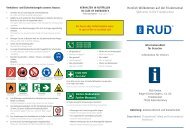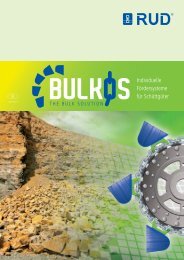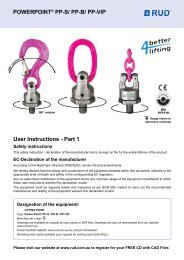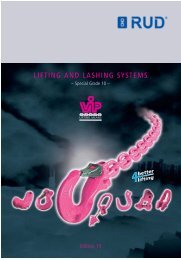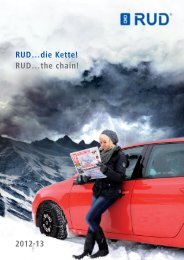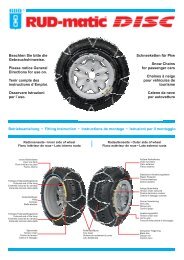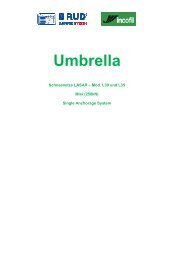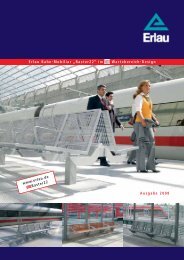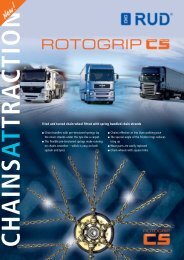Lifting Points for bolt and weld on- User Instructions 2009-12-04 - RUD
Lifting Points for bolt and weld on- User Instructions 2009-12-04 - RUD
Lifting Points for bolt and weld on- User Instructions 2009-12-04 - RUD
Create successful ePaper yourself
Turn your PDF publications into a flip-book with our unique Google optimized e-Paper software.
<str<strong>on</strong>g>Lifting</str<strong>on</strong>g> <str<strong>on</strong>g>Points</str<strong>on</strong>g> <str<strong>on</strong>g>for</str<strong>on</strong>g> <str<strong>on</strong>g>bolt</str<strong>on</strong>g> <str<strong>on</strong>g>and</str<strong>on</strong>g> <str<strong>on</strong>g>weld</str<strong>on</strong>g> <strong>on</strong>- <strong>User</strong> Instructi<strong>on</strong>s -Respect the user instructi<strong>on</strong>s <str<strong>on</strong>g>for</str<strong>on</strong>g> the corresp<strong>on</strong>ding lifting points!Be<str<strong>on</strong>g>for</str<strong>on</strong>g>e every use, please read the <strong>User</strong>Instructi<strong>on</strong> of the <str<strong>on</strong>g>Lifting</str<strong>on</strong>g> <str<strong>on</strong>g>Points</str<strong>on</strong>g> carefully <str<strong>on</strong>g>and</str<strong>on</strong>g>make sure that you underst<str<strong>on</strong>g>and</str<strong>on</strong>g> all substance.Improper use or care of this eye<str<strong>on</strong>g>bolt</str<strong>on</strong>g> can resultin bodily injury or property damage <str<strong>on</strong>g>and</str<strong>on</strong>g>eliminates any warranty!1 Applicati<strong>on</strong> <str<strong>on</strong>g>and</str<strong>on</strong>g> warning in<str<strong>on</strong>g>for</str<strong>on</strong>g>mati<strong>on</strong>Reference should be made to country specific statutoryregulati<strong>on</strong>s <str<strong>on</strong>g>and</str<strong>on</strong>g> installati<strong>on</strong> to be carried out by competentskilled pers<strong>on</strong>s <strong>on</strong>ly.• When h<str<strong>on</strong>g>and</str<strong>on</strong>g>ling the lifting means (sling chain), nosqueezing, shearing, catching <str<strong>on</strong>g>and</str<strong>on</strong>g> impact spots mustoccur.• Damaging of the lifting means <str<strong>on</strong>g>and</str<strong>on</strong>g> lifting points by sharpcorners has to be avoided.• For the assembly of the lifting points, please follow theuser instructi<strong>on</strong>s enclosed.• Be<str<strong>on</strong>g>for</str<strong>on</strong>g>e installati<strong>on</strong> <str<strong>on</strong>g>and</str<strong>on</strong>g> every use, inspect visually <strong>RUD</strong>lifting points, paying particular attenti<strong>on</strong> to any evidenceof corrosi<strong>on</strong>, wear, <str<strong>on</strong>g>weld</str<strong>on</strong>g> cracks <str<strong>on</strong>g>and</str<strong>on</strong>g> de<str<strong>on</strong>g>for</str<strong>on</strong>g>mati<strong>on</strong>s. Pleaseensure compatibility of <str<strong>on</strong>g>bolt</str<strong>on</strong>g> thread <str<strong>on</strong>g>and</str<strong>on</strong>g> tapped hole (seechapter 5 Inspecti<strong>on</strong> criteria).2 General in<str<strong>on</strong>g>for</str<strong>on</strong>g>mati<strong>on</strong>• <strong>RUD</strong>-lifting points must not be used under chemicalinfluences such as acids, alkaline soluti<strong>on</strong>s <str<strong>on</strong>g>and</str<strong>on</strong>g> vapourse.g. in pickling baths or hot dip galvanizing plants.• The material c<strong>on</strong>structi<strong>on</strong> to which the lifting point willbe attached should be of adequate strength to withst<str<strong>on</strong>g>and</str<strong>on</strong>g><str<strong>on</strong>g>for</str<strong>on</strong>g>ces during lifting without de<str<strong>on</strong>g>for</str<strong>on</strong>g>mati<strong>on</strong>s.• The lifting points must be positi<strong>on</strong>ed <strong>on</strong> the load in sucha way that n<strong>on</strong>- permitted loads such as twisting orturnings will be avoided.- For single leg lift, the lifting point should bevertically above the center of gravity of the load.- For two leg lifts, the lifting points must beequidistant to/or above the center of gravity of theload.- For three <str<strong>on</strong>g>and</str<strong>on</strong>g> four leg lifts, the lifting points shouldbe arranged symmetrically around the center ofgravity in the same plane.• Load symmetryThe required WLL of the individual lifting point has to becalculated based <strong>on</strong> the following <str<strong>on</strong>g>for</str<strong>on</strong>g>mulaW LL=Gn x cos ßWLL = Working load limit (kg)G = load weight (kg)n = number of load bearing legsb = angle of inclinati<strong>on</strong> of the individual legto the verticalThe number of bearing legs is:symmetrical unsymmetricalTwo leg 2 1Three/four leg 3 2• The places where the lifting points are fixed should bemarked with colour.3 <str<strong>on</strong>g>Lifting</str<strong>on</strong>g> <str<strong>on</strong>g>Points</str<strong>on</strong>g> <str<strong>on</strong>g>for</str<strong>on</strong>g> <str<strong>on</strong>g>weld</str<strong>on</strong>g> <strong>on</strong>• The <str<strong>on</strong>g>weld</str<strong>on</strong>g>ing should be carried out by an authorised<str<strong>on</strong>g>weld</str<strong>on</strong>g>er acc. to EN 287-1.• Effects of temperatureThe lifting points <str<strong>on</strong>g>for</str<strong>on</strong>g> <str<strong>on</strong>g>weld</str<strong>on</strong>g> <strong>on</strong>, types VLBS, LBS, VRBS,RBS, VRBK <str<strong>on</strong>g>and</str<strong>on</strong>g> RBK can together with the load (e.g.<str<strong>on</strong>g>weld</str<strong>on</strong>g> c<strong>on</strong>structi<strong>on</strong>) be annealed stress-free withoutreducti<strong>on</strong> of WLL. Temperature < 600° C.• Material of the <str<strong>on</strong>g>weld</str<strong>on</strong>g>ing block is S355J2+N (1.0577+N,St 52-3N, B.S. 4360.50D, AISI 1019)• The c<strong>on</strong>necting surfaces must be free from dirt, oil,colour, etc.• Do not <str<strong>on</strong>g>weld</str<strong>on</strong>g> at the red or pink powder coated temperedload ring.• The complete c<strong>on</strong>structi<strong>on</strong> can be annealed stress freeat
4 <str<strong>on</strong>g>Lifting</str<strong>on</strong>g> <str<strong>on</strong>g>Points</str<strong>on</strong>g> <str<strong>on</strong>g>for</str<strong>on</strong>g> <str<strong>on</strong>g>bolt</str<strong>on</strong>g> <strong>on</strong>• With lifting points <str<strong>on</strong>g>for</str<strong>on</strong>g> <str<strong>on</strong>g>bolt</str<strong>on</strong>g> <strong>on</strong>, the WLL’s have to bereduced acc. to the following table:-40° upt to 200°C --> minus 0 %200° upt to 300°C --> minus 10 %300° upt to 400°C --> minus 25 %Temperatures above 400°C are not permitted.• The positi<strong>on</strong> to be designed in such a way that theintroduced <str<strong>on</strong>g>for</str<strong>on</strong>g>ces can be accepted by the basic materialwithout de<str<strong>on</strong>g>for</str<strong>on</strong>g>mati<strong>on</strong>s. German authorities recommendthe following minimum <str<strong>on</strong>g>bolt</str<strong>on</strong>g>ing lengths:1 x M in steel (M = thread size, e.g. M 20)1,25 x M in cast ir<strong>on</strong>2 x M in aluminiumHINT:With shock loadings, twisting or vibrati<strong>on</strong>s,especially with through <str<strong>on</strong>g>bolt</str<strong>on</strong>g>s <str<strong>on</strong>g>and</str<strong>on</strong>g> nuts, anunintenti<strong>on</strong>al dismounting may occur.Possibilities of securing: liquid means such asLoctite (respect manufacturer’s prescripti<strong>on</strong>s)or <str<strong>on</strong>g>for</str<strong>on</strong>g>m closed <str<strong>on</strong>g>bolt</str<strong>on</strong>g> securing such as crown nutwith key, counter nut, etc.• With shock loadings, twisting or vibrati<strong>on</strong>s, especiallywith through <str<strong>on</strong>g>bolt</str<strong>on</strong>g>s <str<strong>on</strong>g>and</str<strong>on</strong>g> nuts, an unintenti<strong>on</strong>al dismountingmay occur. Possibilities of securing: liquid means suchas Loctite or WEICONLOCK (respect manufacturer’sprescripti<strong>on</strong>s) or <str<strong>on</strong>g>for</str<strong>on</strong>g>m closed <str<strong>on</strong>g>bolt</str<strong>on</strong>g> securing such as crownnut with key, counter nut, etc.• Secure in general all lifting points which are installedpermanently, e.g. with glue.• With light metals, n<strong>on</strong> ferrous heavy metals <str<strong>on</strong>g>and</str<strong>on</strong>g> greycast, the thread arrangement has to be chosen in sucha way that the WLL of the thread corresp<strong>on</strong>ds with therespective basic material.• <strong>RUD</strong> will not accept any warranty <str<strong>on</strong>g>for</str<strong>on</strong>g> the use of any <str<strong>on</strong>g>bolt</str<strong>on</strong>g>snot supplied by <strong>RUD</strong>! Minimum quality <str<strong>on</strong>g>for</str<strong>on</strong>g> the basematerial “steel” has to be 1.0037 (St 37).5 Inspecti<strong>on</strong> criteriaAfter fitting, an annual inspecti<strong>on</strong> or so<strong>on</strong>er if c<strong>on</strong>diti<strong>on</strong>sdicate should be undertaken by a competent pers<strong>on</strong>examining the c<strong>on</strong>tinued suitability (at least <strong>on</strong>ce a year).Also after damage <str<strong>on</strong>g>and</str<strong>on</strong>g> special occurrences.• Ensure a tight <str<strong>on</strong>g>bolt</str<strong>on</strong>g> seat (possibly examine torque)• Ensure that lifting point is complete• Complete indicati<strong>on</strong>s of WLL <str<strong>on</strong>g>and</str<strong>on</strong>g> manufacturer• De<str<strong>on</strong>g>for</str<strong>on</strong>g>mati<strong>on</strong>s at bearing parts such as body, suspensi<strong>on</strong>bracket or latch• Mechanical damages such as serious notches,especially in high stress areas• Reducti<strong>on</strong>s of cross secti<strong>on</strong> by wear > 10 %• Str<strong>on</strong>g corrosi<strong>on</strong> (pitting)• Cracks at bearing parts• Cracks or other damages at the <str<strong>on</strong>g>weld</str<strong>on</strong>g> (with lifting points<str<strong>on</strong>g>for</str<strong>on</strong>g> <str<strong>on</strong>g>weld</str<strong>on</strong>g> <strong>on</strong>)• Correct <str<strong>on</strong>g>bolt</str<strong>on</strong>g> size, <str<strong>on</strong>g>bolt</str<strong>on</strong>g> quality <str<strong>on</strong>g>and</str<strong>on</strong>g> thread length• Functi<strong>on</strong> <str<strong>on</strong>g>and</str<strong>on</strong>g> damage of <str<strong>on</strong>g>bolt</str<strong>on</strong>g>s as well as <str<strong>on</strong>g>bolt</str<strong>on</strong>g> thread• With rotating lifting points: easy, jerk free turning betweenupper <str<strong>on</strong>g>and</str<strong>on</strong>g> lower part must be assured• Assembly or fitting of different <str<strong>on</strong>g>bolt</str<strong>on</strong>g> lengths with typesWBG-V <strong>on</strong>ly to be carried out by the manufacturer.For the user it is <str<strong>on</strong>g>for</str<strong>on</strong>g>bidden to disassemble the ballbearing of WBG-V, WBG, PP <str<strong>on</strong>g>and</str<strong>on</strong>g> WPP.• With types PP, WPP, WBG-V <str<strong>on</strong>g>and</str<strong>on</strong>g> WBG check maximumslackness between upper <str<strong>on</strong>g>and</str<strong>on</strong>g> lower part below, size „s“– refer to table. In case the maximum slackness hasbeen exceeded, these types must be taken out <str<strong>on</strong>g>for</str<strong>on</strong>g>service or replacement. These parts must not be loadedto proof load.TypeWPP / PP-..-0,63t to 2,5tWPP / PP-..-4t to 8tWBG-V 0,3 to 0,45WBG-V 0,6 to 2,0WBG-V 3,5 to 5,0WBG 8 to 35Slack „s“max. 1,5 mmmax. 2,5 mmmax. 1,2 mmmax. 1,5 mmmax. 3,0 mmmax. 4,0 mm2 <str<strong>on</strong>g>Lifting</str<strong>on</strong>g> <str<strong>on</strong>g>Points</str<strong>on</strong>g>



